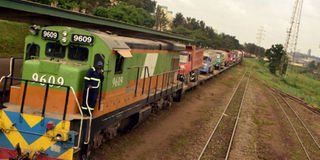SGR: Funding issues won’t affect Uganda Railways

Uganda Railways rail wagon loaded with 24 trucks on arrival at Kampala railway station from Mombasa last year. PHOTO BY MICHAEL KAKUMIRIZI
Last month didn’t close well for Uganda particularly because of the tremors that emanated from Kenya.
In the closing weekend of April, news filtered through, indicating that China had turned down Kenya’s funding request to complete the Naivasha-Malaba segment of the Standard Gauge Railway (SGR).
The tremor of the news sent some shivers down the spine of Uganda’s government.
SGR
However, what is emerging is that the SGR deal being spearheaded by the ministry of Works and Transport is still intact and on the table.
Although according to a senior SGR official who spoke on condition of anonymity for fear of being reprimanded, the five-year implementation timelines for the grand regional project will certainly be affected. But to an extent, the delay is for the better particularly in terms of cost
The SGR – a regional deal involving Uganda, Kenya, Rwanda and South Sudan, is set to attract a better financing deal than it was previously the case.
This is why the earlier financing deal which was going to attract a higher interest rate over time was dropped in favour of making a new bid that is set to render “lower” charges on interest of the loan to be acquired.
Metre-gauge
The objective of developing the SGR network is to provide a modern, fast, reliable, efficient and high capacity railway transport system as a seamless single railway operation.
According to government information, the SGR project is a government project established by Cabinet Minute 107 (CT 2015) to develop a modern, integrated and efficient railway transport system to address both the freight and passenger transportation needs of the country.
Despite this, it does not take away the roles of the metre-gauge, which is one of the oldest mode of transport.
In an interview on Saturday with the managing director of Uganda Railways Corporation, Mr Charles Kateeba, it was clear that the metre-gauge railway is going nowhere.
He said: “No matter what happens with the SGR, there is no way the metre-gauge railway can be dumped. It is like abandoning your first child because you got a second one!”
He continued: “We are the owners of SGR. It is our product. And it will co-exist with SGR. What we need to do is to improve it and that is what we are doing.”
Challenges
Mr Kateeba appears to agree with the assertion that the current funding challenges the SGR project especially from the Kenyan side is undergoing, will have no effect on the Uganda Railway (metre-gauge) operations and plans.
Either way, he said, the metre-gauge railway will feed off the SGR once it is up and running. Currently, the plan is to secure at least Shs38 billion annually over a period of five years to turn around the operation of the oldest railway line in the region.
But even then, the concentration will be to service domestic market. The plan currently is to start with reviving Tororo-Gulu line, then Kampala-Kasese and then the rest like Jinja-Busembatya will follow suit among many other lines.
Thinking differently
The former minister of finance, Professor Ezra Suruma who is currently the chancellor of Makerere University, told Prosper Magazine in a sideline interview of Makerere University Business (MUBS) Economic Forum for a public dialogue on Budgeting for economic transformation and social inclusion recently, that the emphasis should be in developing community access and feeder roads.
These routes, he believes, are more important to farmers and the economy at large than any other mode of transport infrastructure right now. He says with the access and community road, suppliers of raw materials will find it easy to feed the market with their produce.
That is where the emphasis should be as the SGR funding challenges are being sorted out.
Makerere Unversity’s School of Economics lecturer Fred Muhumuza says the government should not use the National budget funds to finance the SGR. He said developing metre-gauge routes for domestic purpose makes much more sense than pumping money into SGR right now.
TIMELINE
2008: Uganda-Kenya moot idea for a new railway line
2010: President Museveni invites China Civil Engineering Construction Corporation to ‘upgrade’ oil railway
2011: Kenya starts negotiations with China
2012: Uganda signs MoU with China Civil Engineering Construction Corporation for railway project
2013: Uganda and Kenya agree on SGR under Northern Corridor Integration Projects




